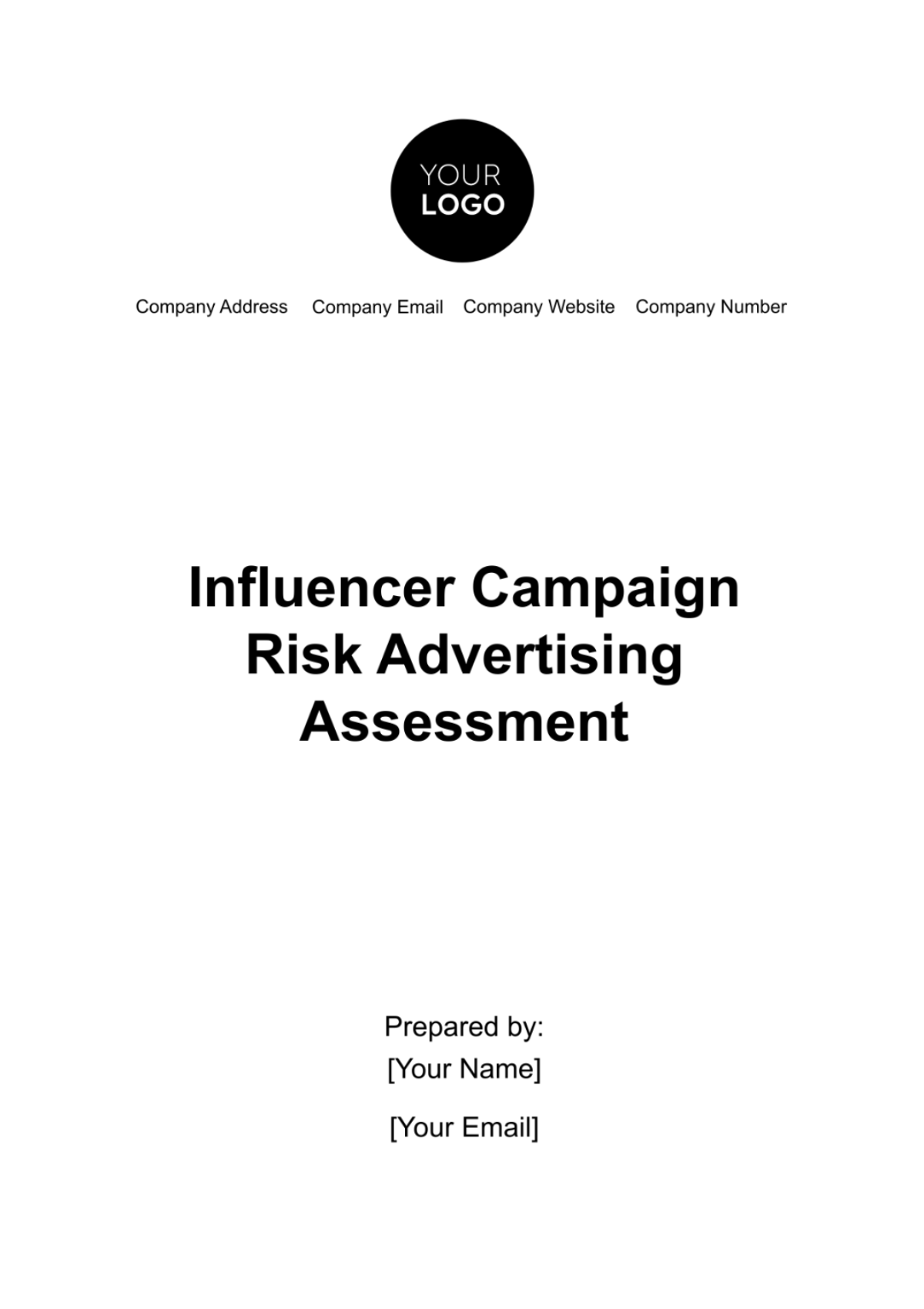Influencer Campaign Risk Advertising Assessment
Executive Summary
This assessment provides a comprehensive analysis of the potential risks associated with influencer marketing campaigns for [Your Company Name]. Leveraging influencers can be a potent strategy. However, it's crucial to recognize and mitigate the risks involved to ensure brand integrity and return on investment (ROI).
Campaign Overview
Objective: Enhance brand awareness and drive sales for [Your Company Name]'s new [Product Name] through an influencer-led campaign, while minimizing potential risks.
Product: [Your Company Name]'s innovative, environmentally-friendly [Product Name], targeting the eco-conscious fitness community.
Campaign Duration: [January 1, 2050 - March 31, 2050].
Target Audience: Health and fitness enthusiasts, aged [18-35], primarily in urban areas.
Selected Influencers: A diverse group of [10] influencers known for their engagement in health, fitness, and sustainability.
Campaign Goals:
Goal | Description | Measurement Metric |
Brand Awareness | Increase brand visibility | Social media mentions, reach |
| | |
| | |
| | |
Influencer Vetting
Influencers were selected based on their follower demographics, engagement rates, content quality, and brand alignment.
Influencer | Followers | Engagement Rate | Content Relevance | Historical Controversies |
[Name] | 150,000 | 3.5% | High | None |
| | | | |
| | | | |
| | | | |
| | | | |
| | | | |
Risks Identified:
Past controversies affecting brand image.
Inauthentic engagement statistics.
Misalignment with brand ethos.
Mitigation Strategies:
Conducting in-depth background checks.
Validating follower demographics and engagement authenticity.
Establishing clear content guidelines reflecting brand values.
Platform Risks
Platforms Utilized:
Instagram: Primary platform due to its popularity among the target demographic.
YouTube: For in-depth product reviews and storytelling.
TikTok: For reaching a younger audience with dynamic, short-form content.
Platform-Specific Risks:
Platform | Risk Factors | Mitigation Plan |
Instagram | Algorithm changes, shadow banning | Diversify content types |
| | |
| | |
| | |
| | |
Strategy:
Regular Monitoring: Keep up with platform updates and community guidelines.
Engagement Analysis: Track changes in engagement patterns and adapt accordingly.
Diversification: Spread content across platforms to mitigate the impact of algorithm changes.
Content & Messaging
Content Guidelines:
Tone & Style: Upbeat, positive, aligned with [Your Company Name]’s brand identity.
Dos and Don'ts: Clearly outlined acceptable and unacceptable content types.
Brand Messaging: Core messages about the product’s eco-friendly aspects and performance features.
Content Risks & Solutions:
Risk Type | Description | Mitigation Steps |
Off-Brand Messaging | Inconsistent with brand values | Pre-approval of key campaign messages |
| | |
Strategy:
Training Sessions: Conduct sessions to familiarize influencers with brand values.
Content Calendar: A structured content timeline for consistency.
Feedback Loop: Establish a system for feedback on content efficacy.
Legal and Compliance
Legal Considerations:
FTC Guidelines: Compliance with endorsement guidelines.
Contractual Agreements: Clear terms regarding content ownership and usage rights.
Data Privacy: Adherence to data protection laws, especially in user engagement.
Compliance Matrix:
Legal Aspect | Description | Compliance Strategy |
Endorsement Rules | Clear disclosure of paid partnership | Mandatory disclosure statements |
| | |
| | |
Strategy:
Legal Workshops: Regular briefings on legal requirements for influencers.
Content Audits: Regular checks to ensure legal compliance.
Legal Team Involvement: Access to legal advice for complex issues.
Financial Implications
Budget Breakdown:
Item | Allocation | Notes |
Influencer Fees | $150,000 | Inclusive of content creation |
| | |
| | |
Risks Identified:
Mitigation Strategies:
Monitoring and Evaluation
Evaluation Metrics:
Metric | Description | Tool/Method |
Reach | Number of unique users reached | Social media analytics |
| | |
| | |
| | |
| | |
Risks Identified:
Mitigation Strategies:
Audience Engagement and Feedback
Monitoring audience engagement and feedback is crucial for understanding the campaign's effectiveness and making necessary adjustments. This section outlines the strategies for tracking and responding to audience interactions.
Engagement Metrics:
Metric | Description | Measurement Tool |
Comment Analysis | Type and sentiment of comments | Sentiment analysis tools |
| | |
| | |
| | |
Strategy
Regular Reporting: Weekly reviews of engagement metrics.
Audience Surveys: Conducting periodic surveys to gather direct feedback.
Responsive Engagement: Encouraging influencers to actively engage with their audience.
Influencer Performance and ROI Analysis
This section focuses on evaluating the performance of individual influencers and the overall return on investment (ROI) of the campaign.
Performance Indicators:
Influencer | Reach | Engagement Rate | Sales Generated | ROI |
[Name] | 1,000,000 | 4.5% | $20,000 | 200% |
| | | | |
| | | | |
Strategy:
Data-Driven Decisions: Using analytics to determine the most effective influencers.
ROI Calculation: Assessing cost versus sales and brand uplift generated by each influencer.
Performance Reviews: Monthly meetings to discuss performance and potential strategy shifts.
Technology and Infrastructure
The right technology and infrastructure are essential for efficiently managing and scaling the influencer campaign.
Technology Stack
Tool/Software | Purpose | Benefit |
Social Media Management Platform | Content scheduling and analytics | Streamlines posting and data collection |
| | |
| | |
| | |
Infrastructure Needs:
Robust Internet Connectivity: Essential for real-time monitoring and communication.
Data Storage and Security: Secure storage solutions for sensitive campaign data.
Collaboration Tools: Platforms to facilitate team collaboration and coordination.
Strategy:
Regular Technology Assessments: Ensuring the tech stack meets evolving campaign needs.
Training Sessions: For team members on new tools and software.
Data Backup and Security Protocols: To safeguard campaign data and communications.
Conclusion
This Influencer Campaign Risk Assessment Document provides a comprehensive and strategic approach to managing the various facets of [Your Company Name] brand's influencer marketing campaign. By systematically addressing key areas - from platform risks and content messaging to legal compliance, crisis management, audience engagement, influencer performance, and technological infrastructure - the document lays a foundation for a proactive and informed campaign management strategy.
Advertising Templates @ Template.net






























